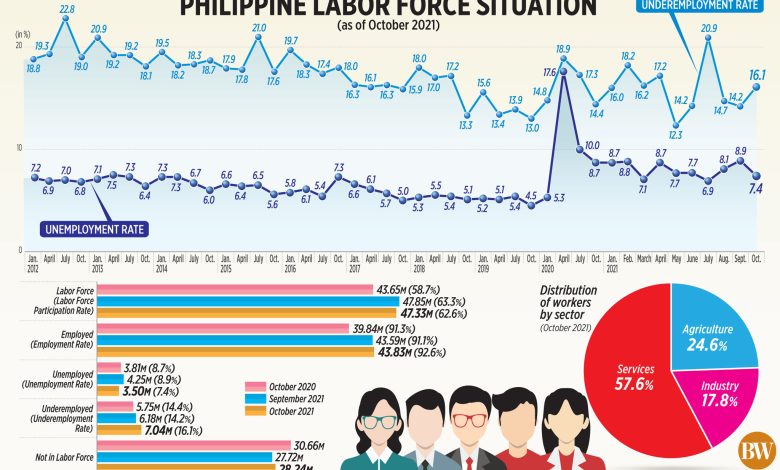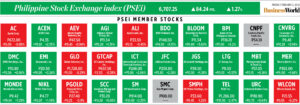Fewer Filipinos jobless in October

THE RANKS of Filipinos who were jobless and looking for work declined in October, while those employed but wanting more work increased from the previous month, latest labor data showed.
The preliminary report of the Philippine Statistics Authority’s (PSA) October round of the labor force survey (LFS) put the country’s unemployment rate at 7.4% compared with 8.9% in the previous round. It was the lowest jobless rate in three months or since July 2021’s 6.9%.
In absolute terms, there were 3.504 million unemployed Filipinos in October, down from 4.255 million in September.
Meanwhile, the quality of available jobs declined as the underemployed rate — the proportion of those already working but still looking for more work or longer working hours — increased to 16.1% from 14.2% in the previous month, equivalent to 7.044 million Filipinos, from 6.183 million a month ago.
The underemployment rate in October was the highest since July’s 20.9%.
The size of the labor force was about 47.330 million in October, down from 47.847 million in September. This brought the labor force participation rate to 62.6% of the working-age population in October from September’s 63.3%.
The employment rate stood at 92.6% of the labor force in October, up from 91.1% in September. This is equivalent to 43.826 million employed individuals during the period from 43.592 million previously.
Services and industry made up 57.6% and 17.8% of total employment in October, respectively, down from 57.8% and 18.7% in September. Meanwhile, agriculture’s share of employment increased to 24.6% from 23.5% a month earlier.
In an online Q&A, the PSA attributed the slight improvements in employment in October to the easing of granular level lockdowns. However, they said the full effects of looser restrictions will be reflected in the November data.
The Philippines on Sept. 16 started enforcing granular lockdowns with five alert levels in its capital region. It initially placed Metro Manila under Alert Level 4, the second-highest level, until Sept. 30. As of Dec. 2, the entire country is now under Alert Level 2, the second most relaxed lockdown level.
IMPROVEMENT SEEN AS ECONOMY REOPENS
In a joint statement, Socioeconomic Planning Secretary Karl Kendrick T. Chua, Department of Finance Secretary Carlos G. Dominguez III, and Department of Budget and Management Officer-in-Charge Tina Rose Marie L. Canda said the October result of the LFS “affirmed the soundness of the government’s push to safely reopen the economy, restore employment, and manage the spread of COVID-19 (coronavirus disease 2019).”
They said the government’s economic development cluster has approved a “10-point agenda” towards making the country a “COVID-19-resilient society” as well as foster further recovery.
The economic managers noted the policy agenda covers the following areas: metrics, vaccinations, healthcare capacity, economy and mobility, schooling, domestic and international travel, digital transformation, pandemic flexibility bill, and medium-term preparation for pandemic resilience.
“Backed by a stronger healthcare system, we will solidify our recovery by reopening the economy to Alert Level 1 in January 2022. At the same time, to avert long-term productivity losses and restore more employment, we will resume face-to-face schooling in January 2022, increase public transport capacity for all transport types to 100%, and relax restrictions for domestic and international travel,” they said.
“We will restore our path towards a more sustainable growth against future crises by enacting pending economic liberalization and digital transformation bills to improve telecommunications services and attract more foreign direct investments,” they added.
Security Bank Corp. Chief Economist Robert Dan J. Roces said in an e-mail that he expects a “steady recovery” in the labor market as economic activities improve in the fourth quarter driven by looser restrictions, an inventory buildup that is seen to favor the manufacturing sector, and increased spending amid the holiday season.
“Upside risks to unemployment as of now is the emergence of new COVID-19 variants which could lead to stricter curbs and job losses once more. Nonetheless, we see the unemployment rate to end the year at around 6.0% in 2021 — or still at elevated levels — before it returns to the pre-pandemic average of 5% in 2022,” Mr. Roces said.
University of the Philippines Professor Emeritus Rene E. Ofreneo shared this view, adding that stimulus spending “matters a lot” as the policy to “go back to the old normal” is not enough, he said in a separate e-mail interview. — Bernadette Therese M. Gadon




